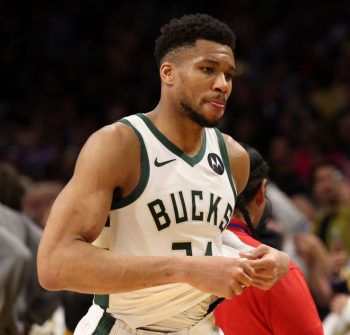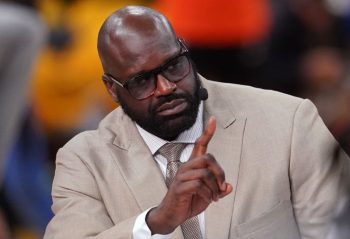NBA
NBA PM: Are We Undervaluing Love?

The 2015-16 NBA Finals ended in spectacular fashion for the Cleveland Cavaliers. The team won a thrilling Game 7 on the road against the Golden State Warriors. Kyrie Irving scored the game-clinching three-point shot. LeBron James had an unbelievable defensive sequence with a coast-to-coast chase down block to preserve the win. And Cavaliers forward Kevin Love had the defensive sequence of his life as he stayed in front of superstar Stephen Curry for an entire possession, ultimately denying Curry a clean look at a crucial three-point shot that missed the mark.
Unfortunately, the 2016-17 NBA Finals didn’t have the same storybook ending for the Cavaliers. There was no signature plays for the Cavaliers stars as the team fell to the Warriors in five games. Plenty of factors are to blame for the loss, the biggest being the addition of forward Kevin Durant to the already loaded Warriors, which made a Cleveland repeat a daunting task. However, at least some of the blame landed at the feet of Love. How much more could Love have done in the Finals?
Despite the long odds and uneven play of several Cavalier players, a good amount of the blame landed at the feet of Kevin Love. So far this offseason, there has been plenty of speculation involving various trade targets the Cavaliers are seeking to acquire. The primary bait in nearly all of these alleged trade proposals is Love. But does anyone really want Love?
In five 2016-17 NBA Finals games, Love scored 16 points, pulled down 11.2 rebounds and notched 2.2 steals per game in 32.2 minutes. As the clear third option on the team, these basic stats show solid contributions. In fact, they are in line with Love’s entire playoff performance where these averages were virtually identical.
Unfortunately, digging deeper you find some more telling statistics. In the playoffs overall, Love had an offensive rating of 118.7 and a defensive rating of 107.2. In the Finals, that reversed for the worse on both the offensive (105.8) and defensive end (119.5). Also, Love’s shooting percentages dropped off across the board. In addition, although he scored well enough in three of the first four games, Love was a no-show in the Game 5 closeout, scoring only six points and failing to make any sort of notable positive impact.
Unlike the Cavaliers championship win the season prior, it is understandable if the 2016-17 NBA Finals left a bad taste in your mouth if you’re a Kevin Love fan. Instead of looking at the immediate past, let’s quickly take a look at who Love was before being traded to the Cavaliers.
Love spent the first six seasons of his career with the Minnesota Timberwolves. He never led his team to the playoffs (nor has anyone else since he left), which could be held against him to a certain degree. However, Love’s Timberwolves teams usually never featured quite enough firepower to be a serious contender anyway. In his last season (2013-14) with the Timberwolves, Love averaged a career-high 26.1 points and 12.5 rebounds, while hitting 2.5 threes on 6.6 attempts in 36.3 minutes per game over 77 total games played.
The following year, Love’s scoring dropped by roughly 10 points, down to 16.4 points per game. Love went from the focal point of the offense, dictating the action from the high post, to being converted to a three-point specialist and rebounder — a role that Love has never truly broken out of. Love will turn 29 by early next season and the hope for a team trading for him is that he would revert to his pre-Cavaliers day when he was considered a top power forward in the league and was even on the short list of top players in the league.
Look no further than forward Chris Bosh for someone who quickly rebounded after making a similar sacrifice as Love in order to be the third star player of a championship team alongside James. Following James’s departure from Miami, Bosh’s averages jumped up in field goals, free throws and three-point shots made and attempted, while his rebounding and assists also jumped up while only playing 3.4 minutes more per game. The biggest dip came in Bosh’s shooting percentages, which dropped due to the higher volume and suffering more attention from opposing defenses without James. Miami was able to build around Bosh and Dwyane Wade, with Bosh resuming a leading man role again as his usage rates returned to the levels he maintained earlier in his career with the Toronto Raptors.
An additional factor working against Love is the way the NBA game is played has shifted so quickly over the past few years. Teams now actively seek out players with greater defensive versatility. The better teams, like the Warriors, will punish opponents who have weaker or limited defensive players. In the Finals, the Cavaliers often couldn’t play Love in critical moments since he struggled to switch and stay in front his opponents consistently. His defensive futility played a role in the Cavaliers’ inability to prevent Golden State from generating open looks at the basket and from three-point range consistently. To address this, the team would often trot out almost retired veteran forward Richard Jefferson in key moments as the team felt more comfortable with Jefferson’s ability to switch on defense and fit alongside Tristan Thompson.
Love’s lack of defensive versatility (e.g., he can’t slide over to center as Bosh did for the HEAT) and his inability to step up in the Finals have played a role in the relative lack of interest in the trade market. Due to Love already being in the prime of his career, it doesn’t make much sense for a rebuilding team (such as the Pacers if they simultaneously trade forward Paul George) to acquire him as Love’s prime won’t match the team’s long term timeline. That leaves potential contenders on the cusp as the most viable trade recipients of Love.
Additionally, there have been rumblings recently regarding inevitable buyouts of various veteran players, including Wade and New York Knicks forward Carmelo Anthony, among others. A potential contender that might trade for Love could presumably wait for teams to start buying out players during the 2017-18 season and seek to sign one of these veterans for a low price and short period of time. It’s unlikely that a player of Love’s caliber would be available through a buyout, but the possibility of adding a similarly talented player while retaining other players and assets that would be lost in a deal for Love may be a more appealing option. With this in mind, it makes sense that Love may not be generating huge interest in the trade market despite his obvious talent.
Love has taken on a smaller role over the last few years as part of a very talented team. Any team trading for Love must hope that he can either revert to the star player he was during his time in Minnesota, or that he can successfully intergrate with a championship contending team that is in need of a sharpshooting big man. Based on his overall play over the last few seasons, neither of those scenarios is a guaranteed outcome.
******
As of the time of this publishing, the NBA has released its selections for the 2016-17 NBA All-Defensive First and Second Teams.
NBA All-Defensive First Team
Forward Draymond Green, Golden State Warriors (198 points)
Center Rudy Gobert, Utah Jazz (196 points)
Forward Kawhi Leonard, San Antonio Spurs (192 points)
Guard Chris Paul, LA Clippers (140 points)
Guard Patrick Beverly (110 points)
NBA All-Defensive Second Team
Guard Tony Allen, Memphis Grizzlies (80 points)
Guard Danny Green, San Antonio Spurs (68 points)
Center Anthony Davis, New Orleans Pelicans (58 points)
Forward Andre Roberson, Oklahoma City Thunder (53 points)
Forward Giannis Antetokounmpo, Milwaukee Bucks (35 points)
******
Basketball Insiders Draft Recap Podcast
Basketball Insiders’ writers Cody Taylor and Spencer Davies talk winners and loser of the NBA Draft, the Jimmy Butler trade, Paul George’s future and the Cleveland Cavaliers.











